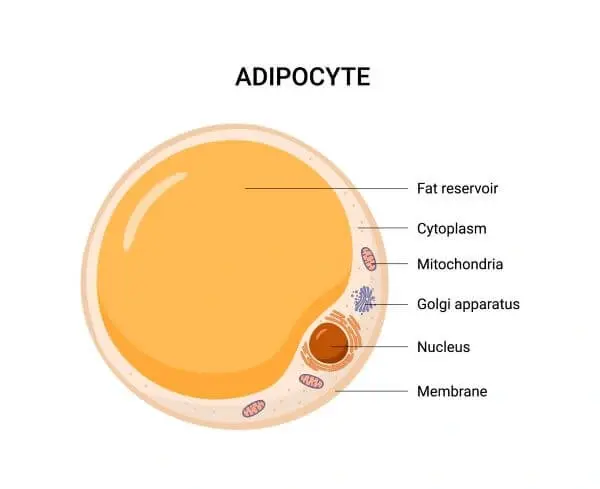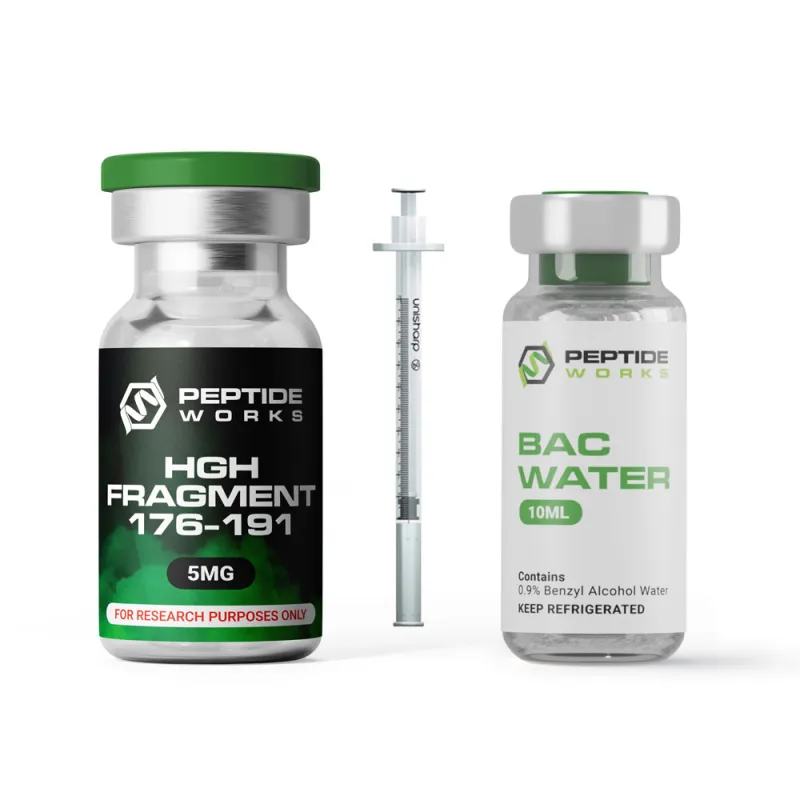
PROMO!
First order? Get 10% OFF with this code: 1storder
Written by

Choosing between HGH Fragment and full-length growth hormone for research can feel hard. You’re not alone in this choice. HGH Fragment has amino acids 176-191 from the full growth hormone chain. This shorter form may focus on fat processes differently than full-length versions.
Full-length HGH191AA has all 191 amino acids and affects muscle, liver, and fat tissues at the same time. These compounds are only for research use. Peptide Works supplies quality research peptides to researchers worldwide.
Understanding why researchers study this short fragment comes down to its unique structure and what it might offer for research.
Explore HGH Fragment 176-191 from Peptide Works, a targeted peptide studied for its potential research applications in fat metabolism studies.

Frustrated with growth hormones that affect too many systems when you only want to study fat? HGH Fragment offers a promising research direction for this problem.
The fragment’s amino acids 176-191 may work differently in the body compared to full-length growth hormone. Researchers are still studying exactly how this happens and what makes it different.
Current evidence suggests the fragment may have different effects compared to full-length variants. This could make metabolic studies easier to understand. Full-length HGH191AA creates well-known broader effects that can interfere with fat-specific research.
Some studies suggest HGH Fragment may influence fat-related processes in ways that create fewer variables for researchers. This makes it useful for researchers focused on fat metabolism studies. This selectivity idea comes from the fragment’s unique structural differences, which is why it interests scientists.
Discover HGH 191AA from Peptide Works, a full-length growth hormone peptide used in research for its wide-ranging effects on muscle growth, metabolism, and tissue regeneration.
Building on these structural differences, the fragment’s research profile is exactly what makes it interesting for targeted studies. HGH Fragment’s short structure may interact differently with fat tissue compared to full-length variants.
This creates new research opportunities that scientists want to explore. However, scientists are still investigating how these interactions work at the cellular level.
Full-length HGH191AA has documented broad effects across liver, muscle, and fat tissues. This creates multiple variables in research studies that can make results harder to interpret. The fragment’s shortened sequence may reduce some whole-body effects.
These effects often frustrate researchers using complete growth hormone molecules. While scientists need more research on the exact ways this works, the structural differences help explain why many researchers explore HGH Fragment for more focused metabolic studies. These structural differences may lead to distinct cell interactions that researchers are working to understand.
Checkout CJC-1295 with DAC from Peptide Works, a long-acting GHRH analog designed to support extended growth hormone release in scientific studies.

Worried about unpredictable responses making your research harder? HGH Fragment’s unique structure offers an interesting alternative approach worth studying.
This connects directly to how the fragment might work at the cellular level. While researchers are still mapping how the fragment works with cells, early findings suggest it may offer more controlled responses than full-length variants.
Full-length HGH191AA causes well-documented complete activation with strong responses. These can hide subtle metabolic effects you’re trying to measure in your studies. HGH Fragment appears to influence different pathways that may create less interference with fat metabolism data collection.
These differences make it a valuable research tool for scientists studying targeted metabolic responses. The pathways that may be influenced by the fragment are particularly relevant to fat metabolism research, which leads us to the specific systems involved.
Here’s where HGH Fragment shows promise for specialized research applications. Early research suggests the fragment may influence certain fat metabolism pathways.
Some studies indicate possible effects on fat-related systems, though these mechanisms need more verification through continued research. The fragment’s different activity profile compared to full-length versions makes it valuable for studying fat processes with potentially fewer confounding variables.
Full-length HGH191AA activates well-documented broader metabolic systems including muscle growth pathways. These complicate fat-specific data collection because they create too many variables at once.
While researchers continue investigating the fragment’s exact mechanisms, its potentially different effects on fat tissue make it an intriguing tool for metabolic studies. The fat-related systems that may be influenced by the fragment deserve special attention, particularly when we look at specific receptors involved in these processes.
Looking for more predictable responses in your fat metabolism research? This brings us to one of the most interesting areas of HGH Fragment research.
The fragment’s potential effects on fat-burning receptors represent an active area of investigation. Some early studies suggest the fragment may influence these receptor systems differently than full-length growth hormone. However, the specific ways this happens need further research to fully understand.
The fragment’s potentially different activity profile indicates it might offer cleaner metabolic responses compared to full-length variants. Full-length HGH191AA produces broader whole-body effects that often create inconsistent responses in fat-specific studies.
The fragment’s research profile makes it valuable for scientists investigating fat metabolism. These receptor systems work with signals your body already produces naturally, which connects to how researchers can use this information.

Understanding natural activation signals helps you design better research protocols. This knowledge builds directly on the receptor research we just discussed. Fat-burning receptors respond to chemicals your body naturally produces.
These include epinephrine from adrenal glands and norepinephrine from nerve endings. These are the same signals that create fight-or-flight responses in your body.
Research suggests HGH Fragment may influence how tissues respond to these natural hormones. However, scientists need more study on the specific mechanisms involved. Full-length HGH191AA creates documented broader effects that can interfere with measuring natural hormone sensitivity.
The fragment’s potential for working with natural responsiveness explains why scientists are investigating fragments. They want studies that give consistent, measurable metabolic responses. With these research directions understood, choosing the right peptide for your studies becomes much clearer and more strategic.
Still unsure which peptide fits your specific research goals? The choice becomes clearer when you consider current evidence and your research needs.
If you’re investigating fat metabolism with fewer variables, HGH Fragment offers a potentially different research profile that may simplify study interpretation compared to full-length versions.
For research requiring comprehensive metabolic effects across multiple tissue systems, full-length HGH191AA provides well-established broader utility with documented multi-system effects. Fragment studies focus on concepts about more targeted fat metabolism research with potentially fewer growth-promoting responses that might interfere with data interpretation.
| Research Comparison | HGH Fragment 176-191 | Full-Length HGH191AA |
|---|---|---|
| Structure | 15 amino acids (176-191) | Complete 191 amino acids |
| Research Focus | Potentially targeted fat studies | Multiple tissue systems |
| Activity Profile | Different from full-length | Well-documented broad effects |
| Study Variables | Potentially fewer complications | Multiple system effects |
| Best Application | Focused metabolic research | Comprehensive studies |
Your research objectives ultimately determine which compound offers the best foundation for your investigations, and quality research-grade peptides from Peptide Works ensure reliable results for your scientific studies.
All products discussed are supplied for research purposes only and are not intended for human use.
[1] Devesa J, Almengló C, Devesa P. Multiple Effects of Growth Hormone in the Body: Is it Really the Hormone for Growth? Clin Med Insights Endocrinol Diabetes. 2016 Oct 12;9:47-71.
[2] Heffernan MA, Jiang WJ, Thorburn AW, Ng FM. Effects of oral administration of a synthetic fragment of human growth hormone on lipid metabolism. Am J Physiol Endocrinol Metab. 2000 Sep;279(3):E501-7.
[3] Ferrer-Lorente R, Cabot C, Fernández-López JA, Alemany M. Combined effects of oleoyl-estrone and a beta3-adrenergic agonist (CL316,243) on lipid stores of diet-induced overweight male Wistar rats. Life Sci. 2005 Sep 2;77(16):2051-8.
[4] Chung JY, Sunwoo JS, Kim MW, Kim M. The neuroprotective effects of human growth hormone as a potential treatment for amyotrophic lateral sclerosis. Neural Regen Res. 2015 Aug;10(8):1201-3.
ALL CONTENT AND PRODUCT INFORMATION AVAILABLE ON THIS WEBSITE IS FOR EDUCATIONAL PURPOSES ONLY.
DISCLAIMER: These products are intended solely as a research chemical only. This classification allows for their use only for research development and laboratory studies. The information available on our Peptide Works website: https://peptide-works.com/ is provided for educational purposes only. These products are not for human or animal use or consumption in any manner. Handling of these products should be limited to suitably qualified professionals. They are not to be classified as a drug, food, cosmetic, or medicinal product and must not be mislabelled or used as such.
Peptide Works
Related Articles

How effective could Orexin Addiction Therapy be?
Have you ever wondered why some people find it so hard to stop addictive habits, even when they truly want

Can NAD Therapy Improve Cognitive Performance?
NAD Therapy is gaining attention in research for its possible role in brain health. NAD+ (nicotinamide adenine dinucleotide) is a

Enhancing Energy with NAD+ Supplements
Energy is the driving force behind focus, movement, and recovery. When cells have less energy to work with, the body